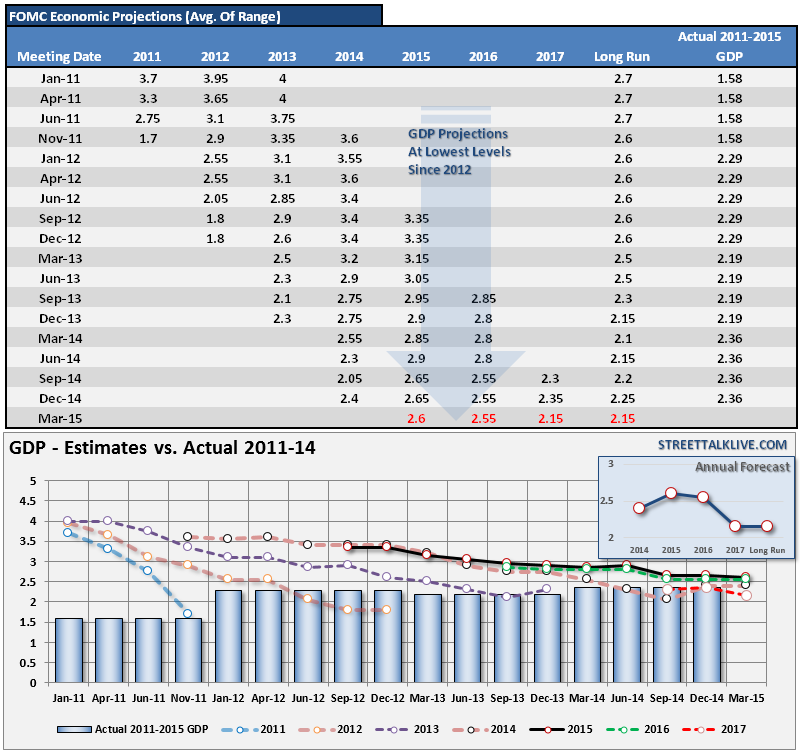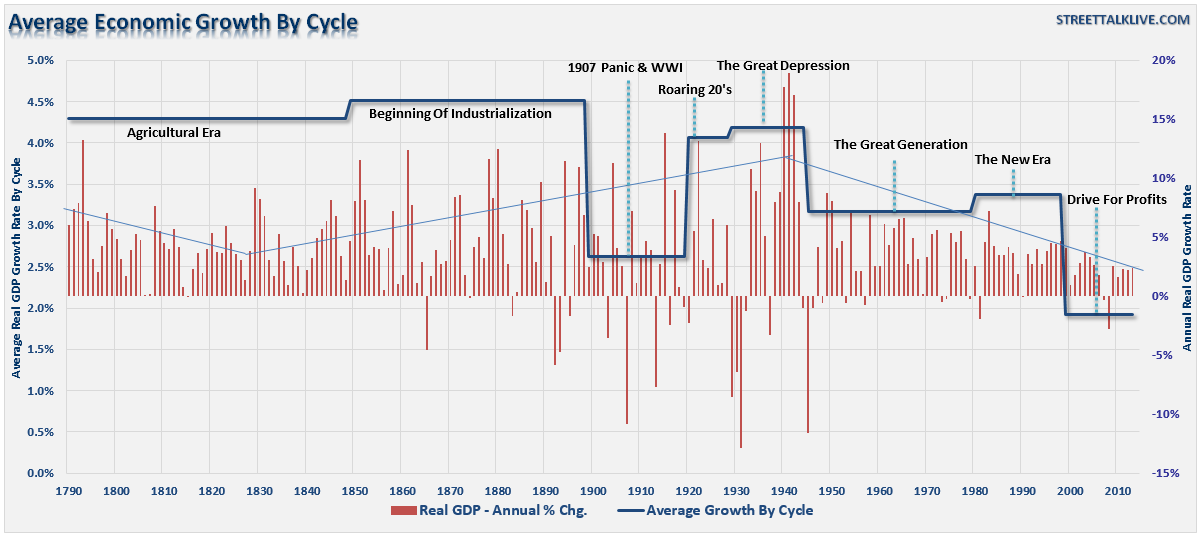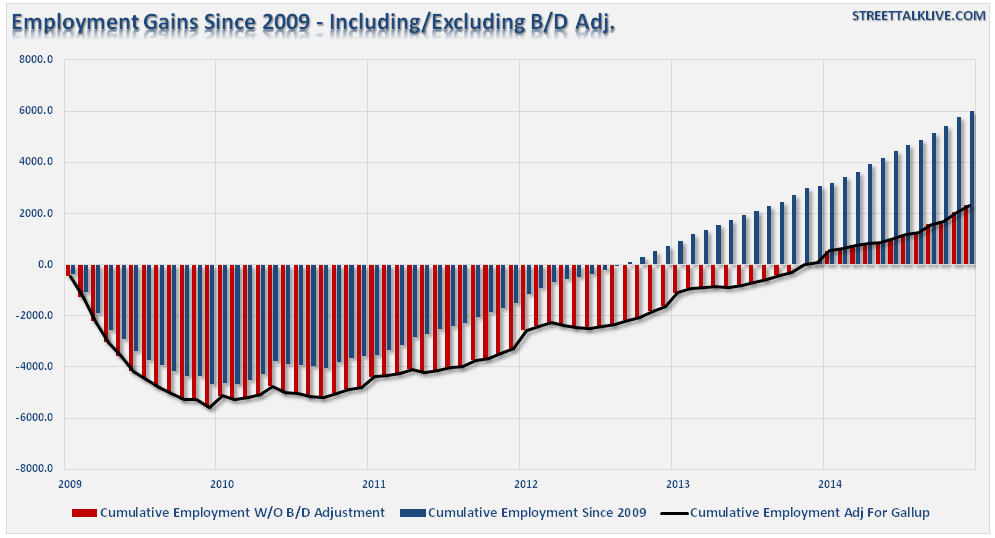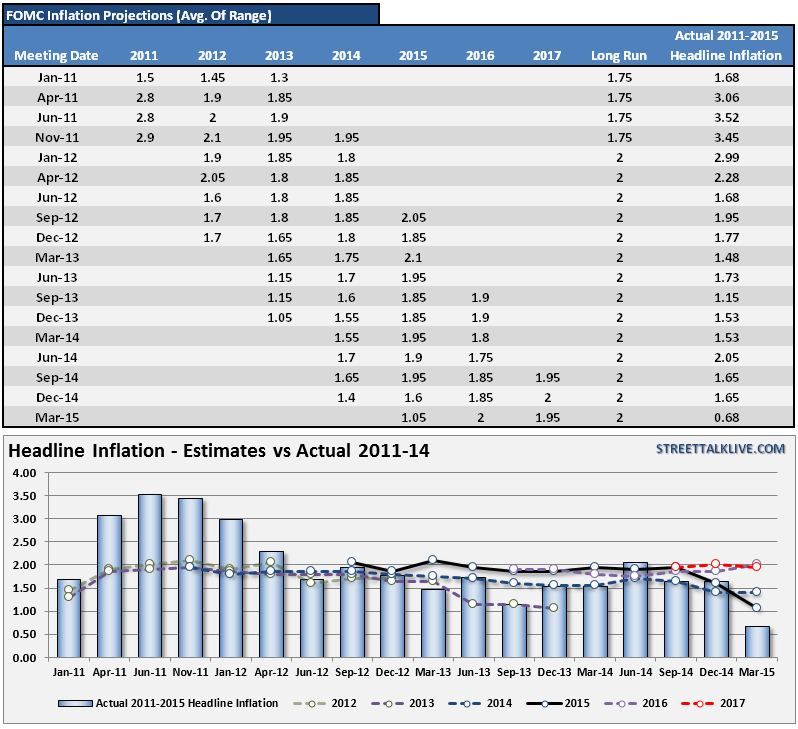I have been tracking the Federal Reserves forward-looking projections ever since they begin releasing their forecasts. The purpose of tracking these projections was to compare the Fed's forecasts with what eventually became reality. The record is now clear...they are the worst economic forecasters...ever.
The most recent release of the Fed's economic projections on the economy, inflation and unemployment continue to follow the same previous trends of weaker growth, lower inflation and a complete misunderstanding of the underpinnings of the real labor market.
Economy
When it comes to the economy, the Fed has consistently overstated economic strength. This is clearly shown in the chart and table below.
Near the end of 2013, the Fed predicted that GDP growth for 2014 would be 3.6%. This was down from 2013's projection of 4% economic growth. Actual real GDP (inflation adjusted) was just 2.36% for the year or roughly a negative 34% difference. However, as you can see in the chart above, the Federal Reserve has been consistently over optimistic about future economic growth.
Unfortunately, 2015 is not shaping up well either. At the beginning of 2014, the estimates for the full year economic growth in 2015 averaged 2.9% down from the 3.35% when first projected in 2012. As of Wednesday, the Fed has downgraded that outlook further and is now predicting growth of just 2.6% for the full year.
This is the lowest rate of economic growth predicted by the since 2012. With the first quarter of 2015 shaping up to be nearly flat (0% growth), it would now require average growth over the next 3 quarters of 3.3% real growth to meet that goal. However, given the current weakening of economic data domestically, the surging dollar impacting exports and global deflationary/recessionary pressures abroad, it is quite likely that, just as in every year past, the Federal Reserve will be reducing their goals further into the year.
Importantly, while Janet Yellen suggested the Fed's economic forecast was "not a weak one," the reality is that it actually was. I have repeatedly stated over the last two years that we are in for a low growth economy due to debt deleveraging, deficits and continued fiscal and monetary policies that are retardants for economic prosperity. The simple fact is that when the economy requires roughly $5 of debt to provide $1 of economic growth -- the engine of growth is broken.
Economic data continues to show signs of sluggishness, despite intermittent pops of activity, and with higher taxes, increased healthcare costs and regulation, the fiscal drag on the economy could be larger than expected.
What is very important is the long run outlook of 2.15% economic growth. As shown in the chart below, real economic growth used to run close to 4%. Today, the Fed's prediction is down markedly from the 2.7% rate they were predicting in 2011.
It is worth noting that it is incredibly difficult to create real economic prosperity when locked into subpar growth rates.That rate of growth is not strong enough to achieve the "escape velocity" required to improve the level of incomes and employment to levels that were enjoyed in previous decades. Has there been a recovery in the economy? Of course, but much of it has only been statistical.
Unemployment
The one area that the Federal Reserve has been fairly accurate has been the unemployment rate. For 2015, the Fed sees unemployment falling to 5.05% and ultimately returning to a 5.35% "full employment" rate in the long run.
Of course, the issue with the "full employment" prediction becomes the definition of what "reality" actually is.
Today, average Americans have begun to question the credibility of the BLS employment reports. Even Congress has made an inquiry into the data collection and analysis methods used to determine employment reports. Since the end of the last recession, employment has improved modestly but that improvement, as shown in full-time employment to population ratio chart below of 16-54 year olds belies the "full employment" levels reported suggested by the Fed.
More importantly, where the Fed is concerned, the drop in the unemployment rate has been due to shrinkage of the labor pool rather than an increase in employment. The chart below shows the unemployment rate as compared to the percentage of the working age population that are no longer consider part of the workforce.
While the unemployment "rate" is declining, it is a very poor measure from which to benchmark the health of the economy. Furthermore, as discussed previously, there is a very high probability that due to the impact of the depth of the last economic recession that the BLS has been overstating employment gains.
"This is an extremely important point as it suggests that employment, as presented by the BLS, has been significantly overstated over the past six years. If we take the differential as stated by Gallup and compare that to the annual birth/death adjustment used by the BLS we find that jobs have been overstated by 3,678,000 or more than 613,000 annually."
Lastly, it is hard to suggest that "employment" is rapidly returning to normal when there are still 30% of college graduates living at home with parents, the highest number of individuals in history over the age of 65 are still working and roughly 1-in-4 Americans on some form of government assistance.
But then again, maybe the Fed has it right? If you just look at the headline statistical data things look a whole lot better.
Inflation
When it comes to inflation, the Fed's projections are only marginally better than their economic forecasts.
The Fed significantly underestimated official rates of inflation in 2011. However, in 2012 and 2013 their projections were more closely aligned. However, since then the Fed has consistently hoped for higher rates of inflation than what has actually occurred. Near the end of 2014, the Fed was predicting inflation for 2015 at nearly 2%, currently inflation has fallen to just 0.68% and with the collapse of oil and commodity prices, shows little sign of rising anytime soon.
The Fed's greatest economic fear is deflation and the stubbornly low levels of inflationary pressures will continue to keep the Fed sidelined longer than most expect.
While the Federal Reserve removed their "patient" status from their meeting notes yesterday, the reality is that they are unlikely going to be able to raise interest rates anytime soon. This was a view that was reiterated by Morgan Stanley (NYSE:MS) yesterday:
"We maintain our expectation that the Fed will err on the side of caution and take to heart the asymmetric risks to tightening policy too early when at the zero lower bound. We see persistently low core inflation as the main stumbling block for those on the Committee that want to become more confident that this period of lowflation does indeed turn out to be transitory. With our expectation that core inflation falls further from goal,and the lingering threats to growth and inflation from the rapid appreciation of the US dollar, we look for the Fed to forego rate hikes this year."
However, there is another point to be considered as I stated previously:
"The real concern for investors and individuals is the actual economy. There is clearly something amiss within the economic landscape, and the ongoing decline of inflationary pressures longer term is likely telling us just that. The big question for the Fed is how to get out of the potential trap they have gotten themselves into without cratering the economy, and the financial markets, in the process.
It is my expectation, unless these deflationary trends reverse course in very short order, that if the Fed raises rates it will invoke a fairly negative response from both the markets and economy. However, I also believe that the Fed understands that we are closer to the next economic recession than not. For the Federal Reserve, the worst case scenario is being caught with rates at the "zero bound" when that occurs. For this reason, while raising rates will likely spark a potential recession and market correction, from the Fed’s perspective this might be the “lesser of two evils.”
You Can't Handle The Truth
However, it is important to understand that the Federal Reserve CAN NOT tell the truth. In a liquidity driven world where the financial markets parse and hang on every word uttered by the heads of Central Banks worldwide, can you imagine what would happen to the financial markets if Janet Yellen stated:
"Despite many years of supporting the financial markets in hopes of a resurgence of economic growth, it is committee's assessment that Keynesian economic theory is flawed. While our monetary interventions have inflated asset prices as desired, it has only served to widen the "wealth gap" while having little effect on the real economy. It is the conclusion of the committee that our policies have failed to achieve realistic economic objectives and has potentially imperiled the financial markets with a third 'asset bubble' in the last 15 years."
The ensuing collapse in the financial markets would immediately create a recessionary environment. Financial markets would crumble as credit markets froze as economic activity plunged. This is why there is such a great emphasis focused on the Federal Reserve statement and the guidance they provide. This is why the FOMC continues to focus on the use of "forward guidance" as a policy tool.
The problem for the Federal Reserve is that they are still looking for that elusive economic recovery to take hold after more than five years. Unfortunately for the Fed, economic recovery cycles do not last forever, and the clock is ticking.







